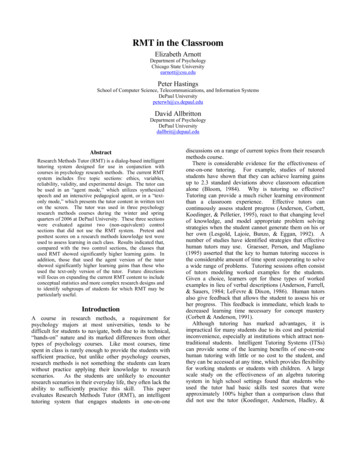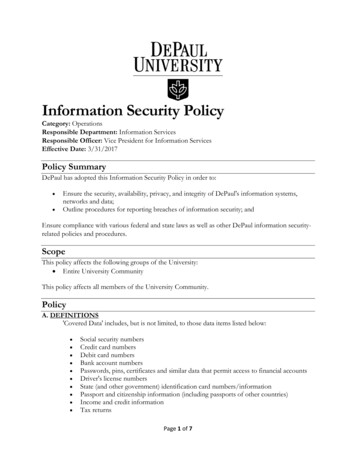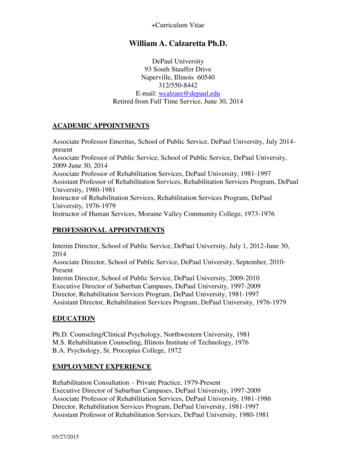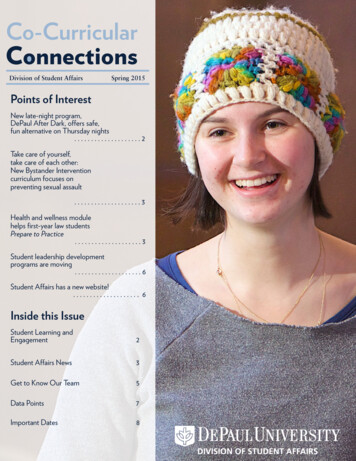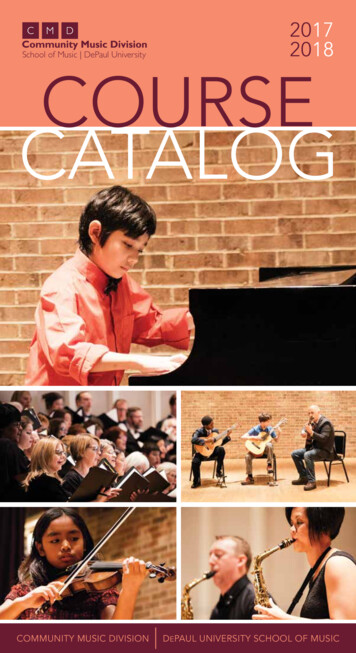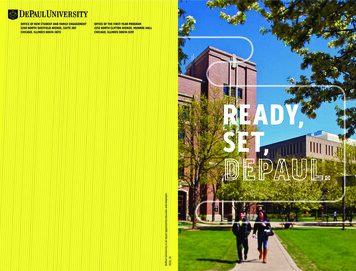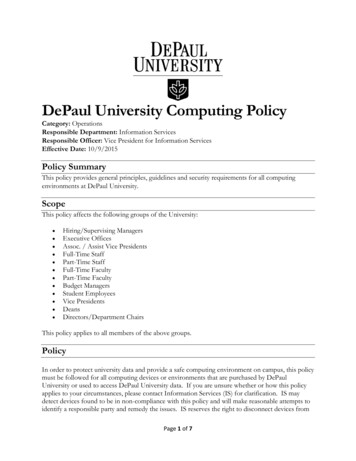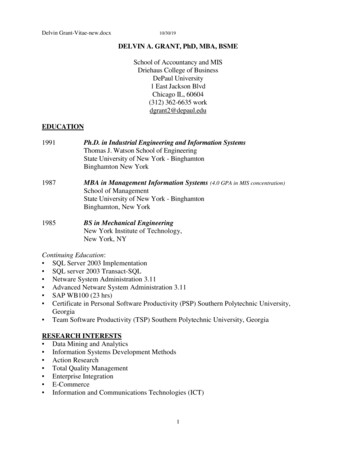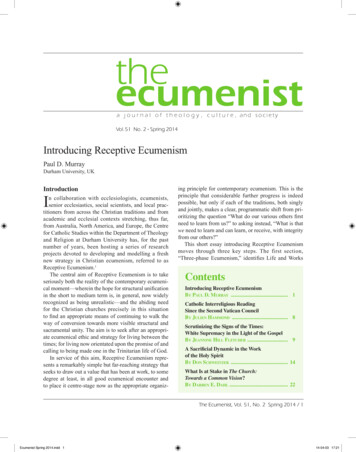
Transcription
a j o u r n a l o f t h e o l o g y , c u l t u r e , and s o c i e t yVol. 51 No. 2 Spring 2014Introducing Receptive EcumenismPaul D. MurrayDurham University, UKIntroductionIn collaboration with ecclesiologists, ecumenists,senior ecclesiastics, social scientists, and local practitioners from across the Christian traditions and fromacademic and ecclesial contexts stretching, thus far,from Australia, North America, and Europe, the Centrefor Catholic Studies within the Department of Theologyand Religion at Durham University has, for the pastnumber of years, been hosting a series of researchprojects devoted to developing and modelling a freshnew strategy in Christian ecumenism, referred to asReceptive Ecumenism.1The central aim of Receptive Ecumenism is to takeseriously both the reality of the contemporary ecumenical moment—wherein the hope for structural unificationin the short to medium term is, in general, now widelyrecognized as being unrealistic—and the abiding needfor the Christian churches precisely in this situationto find an appropriate means of continuing to walk theway of conversion towards more visible structural andsacramental unity. The aim is to seek after an appropriate ecumenical ethic and strategy for living between thetimes; for living now orientated upon the promise of andcalling to being made one in the Trinitarian life of God.In service of this aim, Receptive Ecumenism represents a remarkably simple but far-reaching strategy thatseeks to draw out a value that has been at work, to somedegree at least, in all good ecumenical encounter andto place it centre-stage now as the appropriate organiz-ing principle for contemporary ecumenism. This is theprinciple that considerable further progress is indeedpossible, but only if each of the traditions, both singlyand jointly, makes a clear, programmatic shift from prioritizing the question “What do our various others firstneed to learn from us?” to asking instead, “What is thatwe need to learn and can learn, or receive, with integrityfrom our others?”This short essay introducing Receptive Ecumenismmoves through three key steps. The first section,“Three-phase Ecumenism,” identifies Life and WorksContentsIntroducing Receptive EcumenismBY PAUL D. MURRAY . 1Catholic Interreligious ReadingSince the Second Vatican CouncilBY JULIEN HAMMOND . 8Scrutinizing the Signs of the Times:White Supremacy in the Light of the GospelBY JEANNINE HILL FLETCHER . 9A Sacrificial Dynamic in the Workof the Holy SpiritBY DON SCHWEITZER . 14What Is at Stake in The Church:Towards a Common Vision?BY DARREN E. DAHL . 22The Ecumenist, Vol. 51, No. 2 Spring 2014 / 1Ecumenist Spring 2014.indd 114-04-03 17:21
ecumenism and the traditional bilateral form of Faith andOrder ecumenism as two complementary phases of theecumenical journey that now need extending into a freshthird phase. The second section, “Receptive Ecumenism:Opening a Way for Contemporary Ecumenism,” thenoffers Receptive Ecumenism as this significant nextphase and outlines some of the key principles that areat work in it. In turn, the third section, “Case Studies inReceptive Ecumenical Engagement,” turns to identifya number of examples of practical initiatives in receptive ecumenical learning and closes by highlightingthe forthcoming Third International Conference onReceptive Ecumenism, which is to take place in Juneof this year in Fairfield, Connecticut. The conclusionreflects on the understanding of unity as the full flourishing of difference in communion that is at work inReceptive Ecumenism. A short bibliography of somerelevant works is appended.Three-phase EcumenismThe modern ecumenical movement stemmed fromthe experience of the nineteenth-century Protestantmissionary traditions, which became aware of a significant performative contradiction between the gospel ofreconciliation they were each proclaiming and—actingas powerful counter-witness—the competition over thewinning of souls and turf in which they were effectivelyengaged. As a consequence, from the outset, a fundamental ecumenical concern has been to seek for ways tomove from mutual hostility and mistrust to recognitionand effective collaboration in worship, work, and mission. Following the watershed 1910 Edinburgh WorldMissionary Conference, this concern issued in the Lifeand Works movement, which would later constitute oneof the key streams flowing into the establishment of theWorld Council of Churches in 1948.This was the crucial first phase of ecumenical engagement—first, not only chronologically but also in termsof abiding priority. This ecumenism of life, as it is sometimes called, is to ecumenical engagement as oxygen isto physical life: it is the sine qua non of all attemptedecumenical healing, without which nothing else is possible; and the churches always need more of it. Equally,no matter how much of it there might be, it alone is nevergoing to be sufficient to solve the ecumenical problem.At its heart, the ecumenical problem consists not simplyin breaches of affection, shared prayer, and witness—allof which occur within each of the Christian traditionsand not simply between them—but in the institutional,ministerial, and sacramental divisions that, over centuries, have fomented and cemented such breakdowns.At the heart, then, of the ecumenical problem is thebroken witness the Christian churches give to the worldby not being able to live consistently in full and visiblestructural, sacramental, and ministerial communion.Actions speak louder than words. St. Francis is recordedas telling his friars, “Preach always, and when necessary, use words.” The first way in which the churcheswitness to the Gospel—even before they engage insocial mission—is by their own lives, their own organizational realities. And here the unpalatable truth is thatfor as long as the Christian churches are prevented fromliving in full and visible structural, sacramental, andministerial communion with each other, then they findthemselves in a state of profound lived contradiction,rent by wounds and tears in the ecclesial body of Christ.It is this realization that in turn drove one of the otherkey strands of the modern ecumenical movement, alsoemerging from Edinburgh 1910 and also subsequentlyfeeding into the establishment of the World Councilof Churches: the Faith and Order movement. The coreconcern of Life and Works ecumenism was—and remains—to build shared relationship and practice acrossformally divided traditions. In contrast, the ecumenismof truth or the ecumenism of dialogue focuses on formaldoctrinal and ecclesiological causes of division, andasks how they might be healed and overcome, or howthey might, at least, come to be understood as legitimatedifferences rather than as fundamental divisions. Hereecumenism takes a specifically and self-consciouslyecclesiological form.There have at times inevitably been tensions atvarious points between proponents of Life and Worksecumenism and of Faith and Order ecumenism, but thereis no necessary opposition between them. Indeed, thereis a sense in which Faith and Order ecumenism—theconcern for the formal resolution of points of divisionin order to journey towards full structural, sacramental,and ministerial communion—both follows after andrequires Life and Works ecumenism. On the one hand,the development of relationship with and direct personalexperience of a separated tradition and its memberscan itself serve to promote an urgent desire for theovercoming of all that hinders full communion and sorelease significant energy for the self-consciously ecclesiological work of dialogue. On the other hand, as themany participants in the classical bilateral ecumenicaldialogue processes from the late 1960s onwards attest,2 / The Ecumenist, Vol. 51, No. 2 Spring 2014Ecumenist Spring 2014.indd 214-04-03 17:21
the patient endeavours of the bilateral dialogues weresustained throughout and only able to make the progressthey did on account of the quality of relationship thatgrew between the respective teams of participants.Quite remarkable gains were indeed made by thissecond key phase of ecumenical endeavour, as exemplified by the Anglican–Roman Catholic InternationalCommission (ARCIC), the most influential bilateral ecumenical dialogue in the English-speaking world sinceits inception in 1967 as an outflow from the SecondVatican Council. The methodology and strategies progressively developed by ARCIC in turn shaped the workof all the other bilateral dialogues. Three in particularwere important: 1) demonstrating that some assumeddivisions have been built upon misunderstandingsand caricatures of one tradition by the other; 2) drawing upon new scholarship to show how the traditionscould now more easily say jointly what they previouslyassumed could only be said in opposition; and 3) establishing that harmony between differing theological websdoes not require uniformity of expression but, rather,ease of translation across what can legitimately remaindifferently articulated webs of practice and belief.Throughout the first major phase of ARCIC’s activity(ARCIC I, 1970–81) and continuing well into the second(ARCIC II, 1983–2005), the application of these andrelated strategies revealed that one key area of assumedhistoric division after another was not actually a point ofreal communion-dividing difference: whether teachingsabout the Eucharist, or about ordained priestly ministry,or about the relationship between justification and sanctification. Surfing the considerable energy released byCatholicism’s formal entry into the ecumenical movement during Vatican II (1962–1965), the magnitude ofachievement during the first phase of ARCIC’s activityfed dizzy expectations about the possible realization offull structural, sacramental, and ministerial communionwithin a generation. The essential tasks of the dialoguepartners were to come to the ecumenical table valuingthe other tradition and prepared both to explain one’sown tradition in relation to specifics with sufficient clarity and sophistication as to enable the members of theother tradition to understand it aright and affirm it, andto have their own appreciation of the other’s traditionsimilarly refined, all with a view to coming to reconciledunderstanding.In contrast, however, to those heady days, thecontemporary ecumenical scene seems considerablymore sober and constrained. Indeed, on many frontsand despite the undoubted historic achievements, thestructural, sacramental, and ministerial reconciliationof the traditions now seems further away than ever,causing many to speak of an ecumenical winter or of anecumenical cul-de-sac. The great wave of reconciliationthrough theological clarification appears to have crashedon the beach, dissipating its energy and leaving some ofthe great dialogue documents as the high-water mark ofa tide now turned.This is particularly evident in relation to some ofthe longer-running dialogue processes, where the‘softwood’ of relatively easy early gains has now beenexhausted, giving way to the ‘hardwood’ of lasting substantive differences: differences over the ways in whichthe local churches and the universal Church relate, overdecision making at various levels of church life, andover the nature of eligibility for ordained ministry. Therehave also been significantly differing formal discernments between the traditions in relation to the pastoralcare of gay and lesbian people and the legitimacy ofadmitting women into ordained ministry. Here and inrelated cases, we are not dealing with mere mutualmisunderstandings and differences of articulation thatcan be clarified and relatively easily tidied up. Rather,we are dealing with substantive, long-term differencesthat, at the formal level, are not going to be resolved forthe foreseeable future. It is important to recognize thiswhile also recognizing that on the ground within thetraditions there can be considerable diversity of opinion,with faithful members exploring what possibilities foreventual change might actually lie open.On account, however, of the ecumenically gamechanging nature of these ‘hardwood’ issues at the formallevel, a different, third-phase strategy is required: oneaimed less at short-term harmonization and reconciliation (cf. the second-phase dialogues) and aimed more atlong-term mutual challenge, development, and growthby bringing the traditions into encounter with each otherprecisely in their difference. This third-phase strategyneeds to be aimed less at asking what it is that anothertradition needs to understand better about one’s owntradition and to be aimed instead at asking what it is thatone’s own tradition has to learn and needs to learn fromthe other traditions. Just such a counter-intuitive thirdphase ecumenical strategy has been developed in recentyears under the title of Receptive Ecumenism, guidedboth by theological principle and by pragmatic insight.The Ecumenist, Vol. 51, No. 2 Spring 2014 / 3Ecumenist Spring 2014.indd 314-04-03 17:21
Receptive Ecumenism: Opening a Wayfor Contemporary EcumenismThe operative theological conviction is that if the callto full, visible communion is indeed a gospel imperativethat shares in the reconciling work of the Triune God,then while the formal ecumenical journey might nowbe facing fresh challenges, this should not be mistakeneither for arrival at the end of the road or for an insuperable roadblock. In Christian understanding, God does notmanoeuvre us into corners and blind alleys in order toprod us with a stick for sport; rather, God can be trustedto be faithful to God’s call and to provide the resourcesnecessary to live that call fruitfully in any given context.Similarly, hope, unlike optimism, is not a form of realitydenial that ignores the reality of apparent roadblocks inorder to stay buoyant; on the contrary, hope takes realityseriously in all its problematic aspects and asks how thechurches are resourced to live in the face of and throughthe roadblocks in question.Receptive Ecumenism maintains that while thesecond-phase ecumenical concern to move as directlyas possible to the harmonious reconciliation of apparently contradictory theological frameworks has, at leastfor the time being, now run as far as it can on manyfronts—particularly so in the case of the more maturedialogues—this should not be taken as returning us tothe first-phase ecumenism, where all that is possible is toattend to the quality of relationship, shared prayer, andwitness between divided traditions. Abidingly importantas such first-phase ecumenism undoubtedly remains,there must also be something more: there must be anappropriate means of continuing to walk towards andto live in anticipation of the reality of full communion.For Receptive Ecumenism, this third way is to takeseriously the gospel call to continual renewal and conversion at the heart of Christian life, and to view thechurches collectively as each being on a long-term pathto ecclesial renewal and growth in the face of the other:as being in a state, as Martin Luther would put it, of semper reformandi or, as Vatican II’s Dogmatic Constitutionon the Church, Lumen Gentium, puts it, of semper purificanda. In this perspective, the longer-term ecumenicaljourney on which the Christian churches are embarked,and the recalibration of ecumenical expectation that thispromotes, is not a matter of failure and judgment. It isa consequence of the softwood having been passed andthe hardwood now being engaged. It is a time of gracefor growth towards the goal by the only route possible:that of patient, grace-filled learning of how each is calledto grow to a new place where new things become possible. The fig tree is being given the additional year itrequires if it is to bear fruit.Complementing and reinforcing these theologicalconvictions at work in Receptive Ecumenism are someequally important pragmatic insights and principles.Key here is the recognition that during the same periodthat the churches have come to see the fulfilment of theecumenical goal as being on a slower track than onceenvisaged, they have also come to—or have had forcedupon them by external circumstances—more sober appraisals of their own respective wounds, difficulties, andneeds. Each tradition has specific characteristic difficulties and limitations that are open to view and that canbecome impossible to ignore, but which the tradition inquestion can be incapable of resolving from its own existing resources. Think, for instance, of the widespreadpublic recognition across the full range of Catholicopinion by the time of the election of Pope Francis thatsystemic pathologies around excessive centralism and adecadent bureaucracy needed to be addressed. Seekingto resolve such pathologies using existing internal resources is like a hamster running on a wheel: there mightbe a sense of movement, but no real progress is beingmade. On the contrary, the existing pathological logic issimply being reinforced. There is, consequently, a needfor refreshment and renewal from without, from thealternative logics and ecclesial experiences of other traditions. This in turn is a dynamic process that will takeeach tradition to new places, in the first place for theirown respective health and flourishing, but by so doingalso opening up currently unforeseeable fresh possibilities for their own relating.At the heart, then, of Receptive Ecumenism is theassumption that any further formal progress towardsthe abiding ecumenical goal of full structural andsacramental unity will only be possible if each tradition moves from asking how other traditions need tochange and focuses instead on its own difficulties andtensions and consequent need to learn, or receive, fromthe best discernible practice and associated understanding in other traditions. This reflects a move away fromideal theorized, purely doctrinally driven ecclesiologicalconstructs in ecumenical dialogue and a definite movetowards taking the lived reality of traditions absolutelyseriously, together with the difficulties and problems,tensions and contradictions to be found there.4 / The Ecumenist, Vol. 51, No. 2 Spring 2014Ecumenist Spring 2014.indd 414-04-03 17:21
The general tendency, of course, is to seek to hidesuch wounds, and most certainly to hide them fromthose outside the family circle. Consequently, too muchecumenical engagement is a matter of getting the bestchina tea service out: of showing ourselves somewhatformally in the best possible light to our distant relativeswho are coming to visit rather than allowing the morewarts-and-all self-understanding we keep locked behindthe closed doors of the intimate family space to comeinto view. In contrast, rather than the ecumenism of thebest china tea service, Receptive Ecumenism representsan ecumenism of the wounded hands: of being preparedto show our wounds to each other, knowing that we cannot heal or save ourselves; knowing that we need to beministered to in our need from another’s gift and grace;and trusting that as in the Risen Lord in whose ecclesialbody these wounds exist, they can become sites of ourredemption, jewels of transformed ecclesial existence.This humble yet hopeful spirit of ReceptiveEcumenism resonates strongly with Pope Francis’s recent exhortation during this year’s Octave of Prayer forChristian Unity:It is good to acknowledge the grace with whichGod blesses us and, even more so, to find in otherChristians something of which we are in need,something that we can receive as a gift from ourbrothers and our sisters. The Canadian group thatprepared the prayers for this Week of Prayer hasnot invited the communities to think about whatthey can give their Christian neighbours, but hasexhorted them to meet to understand what all canreceive from time to time from the others. Thisrequires something more. It requires much prayer,humility, reflection and constant conversion. Letus go forward on this path, praying for the unity ofChristians, so that this scandal may cease and beno longer with us.2Case Studies in ReceptiveEcumenical EngagementHigh rhetoric indeed, but what might all this look likein practice? Various initiatives in Receptive Ecumenismhave taken root and developed in different contextsaround the world. The first Receptive Ecumenism project focused on an international research colloquium inJanuary 2006 at Ushaw College, Durham, marking theconferral by the University of an honorary doctorateon Cardinal Walter Kasper. An international team wasinvited to explore, test, and develop the basic thinking atwork in Receptive Ecumenism and, reflecting both theself-critical principle at the heart of the strategy and thespecificity of the host tradition, to apply this thinking toexploring how Roman Catholicism might, with integrity,be fruitfully reimagined in the light of its ecumenicalothers. Further, reflecting the concern not just to theorizeabout the Church but to diagnose and address problemsin its actual lived structures, systems, and practices,alongside the predictable mix of theologians, ecumenists, and ecclesiastics, the colloquium also drew togethera critical complement of social scientists, organizationalexperts, and local church practitioners. The revisedpapers and additional commissioned essays were published in 2008 under the title Receptive Ecumenismand the Call to Catholic Learning: Exploring a Way forContemporary Ecumenism.In turn, extending the concern beyond Catholicismto explore what Receptive Ecumenism might look likein relation to specific traditions, the Second ReceptiveEcumenism International Conference in January2009 (again at Ushaw College, Durham) under thetitle “Receptive Ecumenism and Ecclesial Learning:Learning to Be Church Together,” invited as broad arange as possible of representatives of ecclesial traditions to engage in the exercise of self-critical receptiveecclesial learning from their “others.” At time of writing,the mature results of this exercise, together with othercommissioned pieces, are still in preparation for formalpublication.While these first two conference-based projects delivered the fundamental thinking and basic strategy ofReceptive Ecumenism and tested it out in relation tospecific ecclesial traditions—and sought, moreover, todo so in a way that took account of the socio-cultural andorganizational realities of these traditions, rather thansimply treating them as theorized doctrinal realities—the analyses they each pursued nevertheless tended tooperate at somewhat refined levels. As such, they eachhighlighted the complementary need for a much morepractically focused project that would examine therelevance, viability, and on-the-ground implications ofReceptive Ecumenism at the level of local church life.This recognition issued in a multi-year regional comparative research project in Receptive Ecumenism andthe Local Church, involving the nine major Christiandenominational groupings to be found in the northeastof England, working with a multi-disciplinary teamof ecclesiologists; practical theologians; sociologistsThe Ecumenist, Vol. 51, No. 2 Spring 2014 / 5Ecumenist Spring 2014.indd 514-04-03 17:21
and anthropologists of religion; organizational, humanresource, and financial experts (Durham UniversityBusiness School); church educationalists; ecumenical officers; and other local church practitioners. Thepurpose was to examine how respective difficulties andsticking points in the organizational cultures, structures, and processes of each of the participant churchtraditions, from regional to congregational levels, mightfruitfully be addressed by learning from, or receiving,examples of ‘best practice’ in the other traditions. Thepractical and the organizational act here as portals intothe theological rather than the other way around: askingfirst how the specific difficulties and limitations of onetradition might be tended to by learning and receivingfrom what is strong in the others and then subjectingthese possibilities to rigorous ecclesiological testingagainst the terms of the relevant host tradition.To pursue this end, three research teams have focusedrespectively on Governance and Finance, Ministry andLeadership, and Learning and Formation. First, eachteam conducted a mapping of what is happening, inprinciple, within each denominational grouping, drawing upon extant documentation, formal ecclesiologicalself-understanding, and regulations, together with someinitial interviews. Second, the teams conducted more detailed empirical testing, through structured interviews,questionnaires, focus groups, and participant observation. Third, a series of congregational studies exploredhow these interrelated issues work in the round. Fourth,for each denominational grouping, all the findings deriving from earlier phases were then integrated into a reportidentifying strengths and difficulties—and areas ofpotential receptive learning from the gifts and strengthsof one or more of the other groupings. Fifth, these constructive proposals in turn are being subjected to furtherrigorous testing at the three levels of internal, extensiveand pragmatic coherence: examining whether a particular tradition’s ecclesiological self-understanding canindeed be expanded and rewoven with integrity in orderto accommodate the new insight and practice, whileretaining all that is essential in the host tradition (albeitpotentially transposed and reworked).This formal study in the possibilities that are openat the level of the local church for receptive ecumenicallearning is certainly yielding some significant findingsand possibilities. That said, it needs be acknowledgedthat one of its limitations is the way in which its beingled by a high-powered team of professional theologiansand social scientists can appear to confine the process ofreceptive ecumenical learning to the level of the expertsand to disenfranchise the “ordinary” churchgoer. Withthis, for all the active partnership that was cultivatedwith each of the participant traditions, the fact that theproject has operated somewhat along the lines of anexternal consultancy model has militated to some degree against achieving strong ownership of the project’sresulting findings by the respective traditions.Consequently, what is really required in order to testthe relevance of Receptive Ecumenism at the level of local church life is not a further series of such high-level,relatively externally conducted studies, but a series ofself-initiated self-help projects wherein church membersin a diverse range of contexts ask themselves where thespecific difficulties in their own tradition lie and howthey might fruitfully learn in these regards, with appropriate testing, from other traditions. It is pleasing to notethat a considerable number of just such “bottom-up” local initiatives in Receptive Ecumenism have now arisenin a wide variety of contexts around the world, each ofwhich would repay careful study.Shifting attention, however, for now from such localinitiatives in potential receptive ecumenical learning andonto the formal, international level of bilateral dialogue,it is significant that the third major phase of work of theAnglican–Roman Catholic International Commission(ARCIC III) committed at its first meeting to pursuingits mandated joint focus on the church local and universal and on ethical discernment in receptive ecumenicalmode.3 This is requiring a very challenging move awayfrom the refined articulation of theorized, doctrinallydriven accounts and towards also asking after the livedexperience of decision making in each tradition andthe real difficulties and tensions to be found there. Inkeeping also with the principle of pragmatic coherencebriefly indicated earlier, these difficulties and tensionsare being used as means of probing and testing the theorized accounts and identifying key areas for potentiallyfruitful receptive learning from the other. In proceedingin this way, ARCIC III is making no claim to being ableto overcome at this point the very deep meta-differencesin decision-making structures and processes that pertainbetween Roman Catholicism and Anglicanism. Thatwould be utterly unrealistic. What it is seeking to doinstead is to focus honestly on respective difficultieswithin the traditions as these arise in the experience ofthe concrete church and to make some kind of progress,albeit doubtless more modest than might once have beenhoped for.6 / The Ecumenist, Vol. 51, No. 2 Spring 2014Ecumenist Spring 2014.indd 614-04-03 17:21
Finally, intentionally gathering all such practicalinitiatives thus far in Receptive Ecumenism at a variety of levels and from within a considerable range ofcontexts, the Third Receptive Ecumenism InternationalConference will take place at Fairfield University,Connecticut, from June 9 to 12, 2014, on the theme“Receptive Ecumenism in International Perspective:Contextual Ecclesial Learning.” The dual aim is: 1) togather the total family of those who, in a wide varietyof ways and contexts, have been putting ReceptiveEcumenism to work in order that they might share ongood practice and so contribute to the ongoing development of Receptive Ecumenism; and 2) to invite othersinto engaging this story and its potential in the hope thatthey might in turn be inspired to put it to work in theirown contexts.4Christmas tree—or like a polyphonous choir singingin harmony—in which each unique ornament, eachdistinct voice, is needed for the whole. It is in service ofsuch greater ecclesial flourishing in communion and theresulting collective shining of the church in the world—called to be Lumen gentium, light to the nations—thatthe reparative, critical-constructive task of ecumenicalecclesiology is properly pursued.Conclusion——. “Receptive Ecumenism and Ecclesial Learning:Receiving Gifts for Our Needs,
more sober and constrained. Indeed, on many fronts and despite the undoubted historic achievements, the structural, sacramental, and ministerial reconciliation of the traditions now seems further away than ever, causing many to speak of an ecumenical winter or of an ecumenical cul-de-sac. The great wave of reconciliation

